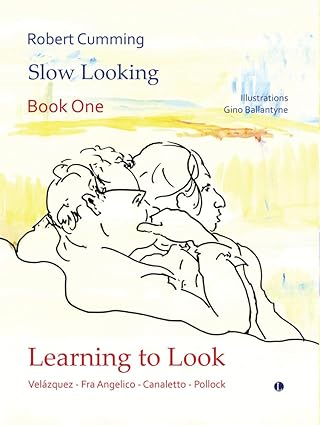Slow Looking: Learning to Look; by Professor Robert Cumming (1962)

SLOW LOOKING is a series of three books about the life enhancing pleasures that can be gained from looking at paintings. Whereas most books about art are full of information cut and pasted from other books and tell you “… what we see here is….” , SLOW LOOKING takes a different approach. First, it asks “what do YOU see?”
Each of us will see something different in a painting, because each of us is different and what we see is shaped by our varying experiences. So that you can understand and appreciate what I see, you need to know briefly who I am (and vice versa). Consequently, each book of SLOW LOOKING starts with a lively autobiographical section. This is followed by a close look at a handful of paintings which have been central to Robert’s experiences of life. Book One, Learning to Look tells of Robert’s childhood during the bleak years of post war austerity where physical comforts and aesthetic pleasures were in short supply, his time at Trinity Hall in the 1960s which were a liberation and taught him how to think for himself; his start in life in London as a young lawyer, how he then began to discover the importance for him of works of art and aesthetic experience, and why he found it necessary to give up a budding law career, and return to Cambridge to study History of Art. Book Two Seeing is Believing (which will be published in the Spring of 2026) describes the art world in the 1970s and Robert’s career at the Tate Gallery and Christie’s. “The art world I joined was run by mad enthusiasts whose chief motivation was the joy of being surrounded by works of art, looking at them, handling them and responding to them, and sharing that enthusiasm with others. It was very different to the rather soulless art world of today where the priorities are either making money, or theoretical discussions about a work of art’s historical or political significance.”
SLOW LOOKING presupposes looking at the painting itself rather than a reproduction, and for rather more than the customary couple of minutes. Robert therefore invites you to accompany him to e.g. Madrid to explore Velazquez’s Las Meninas, or New York to look at Jackson Pollock’s No 1. At the same time, he suggests that you explore these great cities together to see what else they offer, and whether you think the curators have done a good job in their display and presentation of their paintings. Over these two books you will be taken to Vienna, Paris, St Petersburg, New York, Madrid, Tuscany, London and Liverpool, and spend time with Velazquez, Canaletto, Fra Angelico, Jackson Pollock, Matisse, Manet, Bruegel, the Mona Lisa, Turner and Constable.